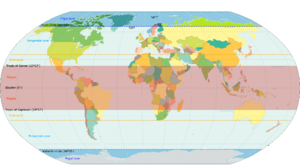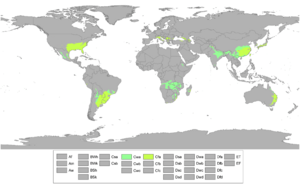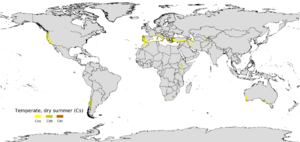Temperate zone facts for kids
Temperate climates are found in the middle parts of Earth, between the hot tropical areas and the cold polar regions. These areas are called the middle latitudes, stretching from about 23.5 degrees north or south of the Equator up to about 66.5 degrees north or south.
Unlike tropical places where it's warm all year, temperate climates have bigger changes in temperature throughout the year. They also have four clear seasons: spring, summer, autumn, and winter. How warm or cold a place is can also depend on things like ocean currents, the direction of the wind, how big the landmass is, and how high up it is (its altitude).
Scientists use systems like the Köppen climate classification to group climates. In this system, a climate is called "temperate" (or "C" climate) if its coldest month usually has an average temperature above −3 °C (26.6 °F) but below 18 °C (64.4 °F). This helps show if frost is common. Some scientists use 0 °C (32.0 °F) as the lowest temperature instead. There are also "continental" (or "D" climate) areas, which are a type of temperate climate but have much colder winters, often below −3 °C (26.6 °F) in the coldest month.
Contents
Temperate Zones Around the World
Earth has two main temperate zones:
- The north temperate zone goes from the Tropic of Cancer (about 23.5 degrees north) up to the Arctic Circle (about 66.5 degrees north).
- The south temperate zone goes from the Tropic of Capricorn (about 23.5 degrees south) down to the Antarctic Circle (about 66.5 degrees south).
Within these large zones, there are different types of temperate climates. These can be divided based on how warm or cold the months are and how much rain falls. Some of these smaller zones include the subtropical zone and the cool temperate zone.
Subtropical Climates
Subtropical climates are found closer to the equator, usually between 23.5 and 35 degrees north or south. Because they are closer to the tropics, they are warmer than other temperate climates. They typically have long, hot summers and mild, short winters. It rarely freezes in these areas.
Humid Subtropical (Cfa) and Monsoon Subtropical (Cwa) Climates
In humid subtropical climates, summers are long, hot, and often rainy with thunderstorms. The most rain usually falls in the hottest months. Winters are generally mild and not freezing. Warm ocean currents often flow near coastal areas with this climate.
You can find humid subtropical climates in places like:
- Southeast and central Argentina, Uruguay, and southern Brazil.
- The southeastern parts of East Asia.
- The southern, northeastern, and midwestern United States.
- Parts of South Africa, Ethiopia, and eastern Australia.
Some humid subtropical areas, especially in southeast China and North India, have a very clear wet and dry season. This is called a monsoon subtropical climate (Cwa). Here, winters are quite chilly and dry, while summers have very heavy rainfall. In some parts of southern China, over 80% of the yearly rain falls during the five warmest months because of the southwest monsoon.
Mediterranean Climates (Csa, Csb)
Mediterranean climates are different from humid subtropical ones because they have dry summers and wet winters. These climates are mostly found on the western edges and coasts of continents. They are next to dry deserts on one side, which bring dry winds in summer. On the other side, they are influenced by cool ocean currents and air masses that bring winter rain.
The five main regions with Mediterranean climates are:
- The Mediterranean Basin (around the Mediterranean Sea).
- Coastal California in the United States.
- The southwest of Australia.
- The Western Cape of South Africa.
- The south and southwestern coast of Chile.
Subtropical Highland Climates (Cwb, Cfb)
Subtropical highland climates are a type of oceanic climate found in mountainous areas, either in the tropics or subtropics. They usually have mild temperatures all year. In subtropical areas, they have four seasons, but in tropical areas, they stay mild to cool most of the year without clear seasons.
- Subtropical highland climates classified as Cfb usually have rain spread fairly evenly throughout the year.
- Climates classified as Cwb have a strong monsoon influence, meaning dry winters and wet summers.
Middle Latitude Climates
These climates are found in the middle of the temperate zones, roughly between 35 and 66.5 degrees north and south. They are influenced by both the polar and tropical zones. There are two main types here: milder oceanic climates and more extreme continental climates. Most temperate climates in this zone have four distinct seasons, especially in continental areas.
Oceanic Climates (Cfb)
Oceanic climates are created by winds blowing from the cool, high-latitude oceans onto the land. This makes summers mild and winters cool (but not freezing cold). Rain and humidity are spread fairly evenly throughout the year. These places are often cloudy and cool, and their winters are milder than those in continental climates.
Places with oceanic climates include:
- Northwestern Europe.
- Northwestern North America.
- Southeastern and southwestern South America.
- Southeastern Australia and most of New Zealand.
Humid Continental Climates (Dfa, Dfb, Dwa, Dwb, Dsa, Dsb)
Humid continental climates are considered a type of temperate climate because they are in the temperate zones. However, they are classified separately in the Köppen system. These climates are found in large land areas and are affected by seasonal changes in wind direction. This causes them to have more extreme temperatures than other temperate climates, with hot summers and cold winters. Rain can be spread evenly throughout the year, or some places might get more rain in the summer.
Regions with humid continental climates include:
- Southeastern Canada.
- The upper parts of the eastern United States.
- Parts of eastern Europe.
- Parts of China, Japan, and the Korean Peninsula.
Subpolar Climates
Subpolar climates are found at the colder edges of the temperate zone, closer to the polar regions. They still have four distinct seasons, including a warmer one, but they are much more influenced by the cold polar zones than other temperate climates.
Subpolar Oceanic and Cold Subtropical Highland Climates (Cfc, Cwc)
Areas with subpolar oceanic climates are like oceanic climates but are closer to the poles. This means they are generally cooler. Snowfall is more common here than in other oceanic climates. They don't have the extreme temperatures of subarctic or continental climates, with milder winters but similar summers.
You can find this climate in:
- Coastal Iceland.
- The Faroe Islands.
- Parts of Scotland.
- Northwestern coastal areas of Norway.
- The Aleutian Islands of Alaska and northern parts of the Alaskan Panhandle.
- Some parts of Southern Argentina and Chile.
- A few highland areas of Tasmania, the Australian Alps, and Southern Alps / Kā Tiritiri o Te Moana in New Zealand.
- Even in tropical areas like the Papuan Highlands in Indonesia.
In these places, even in the middle of summer, temperatures above 20 °C (68 °F) are rare.
A cold version of the monsoon-influenced subtropical highland climate (Cwc) is found in small areas in Yunnan, Sichuan (China), and parts of Bolivia. Here, summers are short and cool because of the high altitude. El Alto, Bolivia, is one of the few towns with this climate.
Cold Summer Mediterranean Climates (Csc)
Cold summer Mediterranean climates (Csc) are found in high mountain areas near coastal Mediterranean (Csb) climates. The strong ocean influence keeps the average winter monthly temperature from dropping below 0 °C (32 °F). This climate is rare and mostly found in isolated areas of the Cascades and Andes Mountains.
Subarctic Climates (Dfc, Dfd, Dwc, Dwd, Dsc, Dsd)
Subarctic climates are a type of continental climate found in the subpolar zones. They are usually found in large land areas far from the ocean's moderating effects, generally between 50 and 70 degrees north latitude. This means they have very extreme temperatures for the season, with warm summers and very cold winters. Rain can be spread throughout the year, or some places might get more rain in the summer.
Regions with subarctic climates include:
- Most of Canada.
- The state of Alaska in the United States.
- Parts of northern Europe.
- Parts of China and Russia.
People and Nature in Temperate Zones
Population, Animals, and Plants
Most of the world's people live in temperate zones, especially in the Northern Hemisphere. This is because there's more land there, and the temperatures are not too extreme. Southern Africa has a huge variety of plants and animals, with about 24,000 different types described in its temperate regions.
Farming
Farming is very common in temperate regions (except for the very cold subarctic areas). This is because there's plenty of rain and warm summers, which are great for growing crops. Most farming happens in spring and summer, so cold winters don't usually affect how much food is grown. Very extreme winters or summers can, however, impact how much food is produced.
Cities
Since most people live in temperate regions, many large cities are found here. The climate in big cities can be different from the climate in rural areas nearby. One reason is that buildings and asphalt absorb more heat from the sun than natural land. Another big reason is the heat released from burning fossil fuels in buildings and vehicles. These factors make the average climate in cities warmer than the areas around them, creating what is called an "urban heat island".
See also
 In Spanish: Clima templado para niños
In Spanish: Clima templado para niños
- Geographical zone
- Habitat
- Köppen climate classification
- Middle latitudes
- Polar circle
- Subtropics
- Tropics
- Subarctic
- Highland temperate climate
- Humid temperate climate
- Subhumid temperate climate





